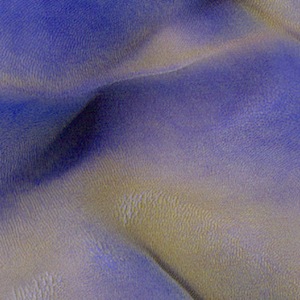 Why are these dunes different colors? Sand on Mars is typically dark in tone, as it commonly derived from volcanic rocks like lava flows. In HiRISE enhanced color, which operates in long infrared wavelengths (beyond what the human eye can detect), surfaces like these dune crests are dark blue to purple. Sand comes in sizes that are ideal for surface transport by the wind, where sand “hops” along forming bedforms, like these dunes after large amounts of time. The lighter toned “tan” or “reddish” surfaces are indeed composed of…. [More at link]
Why are these dunes different colors? Sand on Mars is typically dark in tone, as it commonly derived from volcanic rocks like lava flows. In HiRISE enhanced color, which operates in long infrared wavelengths (beyond what the human eye can detect), surfaces like these dune crests are dark blue to purple. Sand comes in sizes that are ideal for surface transport by the wind, where sand “hops” along forming bedforms, like these dunes after large amounts of time. The lighter toned “tan” or “reddish” surfaces are indeed composed of…. [More at link]
-
Recent Posts
Archives
Links
general
mission instruments
- CRISM: Compact Reconnaissance Imaging Spectrometer for Mars
- CTX: Context Camera
- HiRISE: High Resolution Imaging Science Experiment
- MARSIS: Mars Advanced Radar for Subsurface and Ionosphere Sounding
- SHARAD: Shallow Radar
- THEMIS: Thermal Emission Imaging System
missions
- All Mars missions list
- Curiosity rover
- ExoMars
- Hope (al-Amal) orbiter
- InSight
- Mars Atmosphere and Volatile Evolution Mission (MAVEN)
- Mars Exploration Rovers (MER)
- Mars Express (MEX)
- Mars Odyssey
- Mars Orbiter Mission (MOM) / Mangalyaan
- Mars Reconnaissance Orbiter (MRO)
- Mars Science Laboratory (MSL)
- Perseverance Rover
- Tianwen-1 orbiter/rover
news








